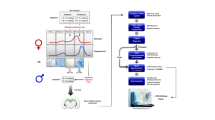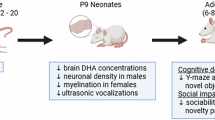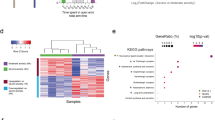Abstract
Glucocorticoids are the consensus treatment for preventing respiratory distress syndrome in preterm infants but there is emerging evidence of subsequent neurobehavioral abnormalities, independent of somatic growth effects. Pregnant rats were given 0.2 mg/kg of dexamethasone, a dose commensurate with clinical use, on gestational days 17–19 and behavioral evaluations were made on the offspring in adolescence and adulthood. The dexamethasone groups had the same body weights as the controls but nevertheless displayed long-term, sex-selective alterations in locomotor and cognitive behaviors. In the figure-8 activity apparatus, dexamethasone treatment ablated the normal sex differences in locomotor activity by reducing values in females to the lower level typical of males; habituation of activity similarly was impaired in females, reducing the profile to match that of control males, while male rats in the dexamethasone group showed a partially feminized pattern of habituation. In the 8-arm radial maze, control rats displayed typical sex differences, with male rats performing more accurately than females. Dexamethasone treatment eliminated this normal dichotomy, delaying learning in males while improving performance in females to the level normally seen in control males. Finally, we assessed hippocampal [3H]hemicholinium-3 binding as a biomarker for cholinergic synaptic activity, and again found loss of sex differences in the dexamethasone group: values in males were increased to the higher levels typical of females. These results indicate that gestational treatment with dexamethasone obtunds the normal sex differences in neurochemistry and behavior that are typically seen in adolescence in adulthood, thus producing sex-selective alterations in activity, learning, and memory.
Similar content being viewed by others
Log in or create a free account to read this content
Gain free access to this article, as well as selected content from this journal and more on nature.com
or
References
Aubert I, Cecyre D, Gauthier S, Quirion R (1996). Comparative ontogenic profile of cholinergic markers, including nicotinic and muscarinic receptors, in the rat brain. J Comp Neurol 369: 31–55.
Bakker JM, van Bel F, Heijnen CJ (2001). Neonatal glucocorticoids and the developing brain: short-term treatment with life-long consequences? Trends Neurosci 24: 649–653.
Barrington KJ (2001). The adverse neuro-developmental effects of postnatal steroids in the preterm infant: a systematic review of RCTs. BMC Pediatr 1: 1–9.
Benesová O, Pavlík A (1989). Perinatal treatment with glucocorticoids and the risk of maldevelopment of the brain. Neuropharmacology 28: 89–97.
Bohn MC (1984). Glucocorticoid induced teratologies of the nervous system. In: Yanai J (ed). Neurobehavioral Teratology. Elsevier: Amsterdam. pp 365–387.
Bowman RE, MacLusky NJ, Sarmiento Y, Frankfurt M, Gordon M, Luine VN (2004). Sexually dimorphic effects of prenatal stress on cognition, hormonal responses, and central neurotransmitters. Endocrinology 145: 3778–3787.
Crofton KM, Howard JL, Moser VC, Gill MW, Reiter LW, Tilson HA et al (1991). Interlaboratory comparisons of motor activity experiments: Implications for neurotoxicological assessments. Neurotoxicol Teratol 13: 599–609.
Crowther CA, Harding J (2003). Repeat doses of prenatal corticosteroids for women at risk of preterm birth for preventing neonatal respiratory disease. Cochrane Database Systemat Rev 1: CD003935.
Dammann O, Matthews SG (2001). Repeated antenatal glucocorticoid exposure and the developing brain. Pediatr Res 50: 563–564.
Dean F, Yu C, Lingas RI, Matthews SG (2001). Prenatal glucocorticoid modifies hypothalamo–pituitary–adrenal regulation in prepubertal guinea pigs. Neuroendocrinology 73: 194–202.
Ferguson SA, Holson RR (1999). Neonatal dexamethasone on day 7 causes mild hyperactivity and cerebellar stunting. Neurotoxicol Teratol 21: 71–76.
Finer NN, Craft A, Vaucher YE, Clark RH, Sola A (2000). Postnatal steroids: short-term gain, long-term pain? J Pediatr 137: 9–13.
Flagel SB, Vazquez DM, Watson SJ, Neal CR (2002). Effects of tapering neonatal dexamethasone on rat growth, neurodevelopment, and stress response. Am J Physiol 282: R55–R63.
Fuxe K, Cintra A, Chadi G, Gustafsson JÅ, Agnati LF (1994). Central glucocorticoid receptors and neuronal plasticity. Methods Neurosci 22: 372–382.
Fuxe K, Diaz R, Cintra A, Bhatnagar M, Tinner B, Gustafsson JA et al (1996). On the role of glucocorticoid receptors in brain plasticity. Cell Mol Neurobiol 16: 239–258.
Gilad GM, Gilad VH, Eliyayev Y, Rabey JM (1998). Developmental regulation of the brain polyamine-stress-response. Int J Dev Neurosci 16: 271–278.
Gilstrap LC, Christensen R, Clewell WH, D'Alton ME, Davidson EC, Escobedo MB et al (1994). Effect of corticosteroids for fetal maturation on perinatal outcomes. J Am Med Assoc 273: 413–418.
Golub MS, Hogrefe CE, Germann SL, Jerome CP (2004). Endocrine disruption and cognitive function in adolescent female rhesus monkeys. Neurotoxicol Teratol 26: 799–809.
Gould E, Tanapat P, McEwen BS (1997). Activation of the type 2 adrenal steroid receptor can rescue granule cells from death during development. Dev Brain Res 101: 265–268.
Happe HK, Murrin LC (1992). High-affinity choline transport regulation by drug administration during postnatal development. J Neurochem 58: 2053–2059.
Holson RR, Gough B, Sullivan P, Badger T, Sheehan DM (1995). Prenatal dexamethasone or stress but not ACTH or corticosterone alter sexual behavior in male rats. Neurotoxicol Teratol 17: 393–401.
Icenogle LM, Christopher C, Blackwelder WP, Caldwell DP, Qiao D, Seidler FJ et al (2004). Behavioral alterations in adolescent and adult rats caused by a brief subtoxic exposure to chlorpyrifos during neurulation. Neurotoxicol Teratol 26: 95–101.
Jobe AH (2000). Glucocorticoids in perinatal medicine: misguided rockets? J Pediatr 137: 1–3.
Kamphuis PJ, Gardoni F, Kamal A, Croiset G, Bakker JM, Cattabeni F et al (2003). Long-lasting effects of neonatal dexamethasone treatment on spatial learning and hippocampal synaptic plasticity: involvement of the NMDA receptor complex. FASEB J 17: 911–913.
Kamphuis PJGH, Croiset G, Bakker JM, van Bel F, van Ree JM, Wiegant VM (2004). Neonatal dexamethasone treatment affects social behaviour of rats in later life. Neuropharmacology 47: 461–474.
Kawata M, Yuri K, Ozawa H, Nishi M, Ito T, Hu Z et al (1998). Steroid hormones and their receptors in the brain. J Steroid Biochem Mol Biol 65: 273–280.
Keppel G (1982). Design and Analysis: A Researcher's Handbook. Prentice-Hall: Englewood Cliffs, NJ, 699pp.
Klemm N, Kuhar MJ (1979). Post-mortem changes in high affinity choline uptake. J Neurochem 32: 1487–1494.
Levin ED, Addy N, Baruah A, Elias A, Christopher NC, Seidler FJ et al (2002). Prenatal chlorpyrifos exposure in rats causes persistent behavioral alterations. Neurotoxicol Teratol 24: 733–741.
Levin ED, Addy N, Christopher NC, Seidler FJ, Slotkin TA (2001). Persistent behavioral consequences of neonatal chlorpyrifos exposure in rats. Dev Brain Res 130: 83–89.
Levitt NS, Lindsay RS, Holmes MC, Seckl JR (1996). Dexamethasone in the last week of pregnancy attenuates hippocampal glucocorticoid receptor gene expression and elevates blood pressure in the adult offspring in the rat. Neuroendocrinology 64: 412–418.
Maccari S, Darnaudery M, Morley-Fletcher S, Zuena AR, Cinque C, Van Reeth O (2003). Prenatal stress and long-term consequences: implications of glucocorticoid hormones. Neurosci Biobehav Rev 27: 119–127.
Machhor N, Balaji T, Raju TN (2004). Postnatal dexamethasone and long term learning and memory functions in developing rats: effect of postnatal age and gender. Life Sci 74: 1925–1935.
MacLusky NJ, Naftolin F (1981). Sexual differentiation of the central nervous system. Science 211: 1294–1302.
MacLusky NJ, Philip A, Hurlburt C, Naftolin F (1985). Estrogen formation in the developing rat brain: sex differences in aromatase activity during early postnatal life. Psychoneuroendocrinology 10: 355–361.
Marmendal M, Roman E, Eriksson CJ, Nylander I, Fahlke C (2004). Maternal separation alters maternal care, but has minor effects on behavior and brain opioid peptides in adult offspring. Dev, Psychobiol 45: 140–152.
Masuo Y, Ishido M, Morita M, Oka S (2004). Effects of neonatal treatment with 6-hydroxydopamine and endocrine disruptors on motor activity and gene expression in rats. Neural Plasticity 11: 59–76.
Matthews SG (2000). Antenatal glucocorticoids and programming of the developing CNS. Pediatr Res 47: 291–300.
Matthews SG, Owen D, Banjanin S, Andrews MH (2002). Glucocorticoids, hypothalamo–pituitary–adrenal (HPA) development, and life after birth. Endocr Res 28: 709–718.
McCarthy MM (1994). Molecular aspects of sexual differentiation of the rodent brain. Psychoneuroendocrinology 19: 415–427.
McEwen BS (1992). Steroid hormones: effect on brain development and function. Hormone Res 37: 1–10.
Meaney MJ, Diorio J, Francis D, Widdowson J, LaPlante P, Caldji C et al (1996). Early environmental regulation of forebrain glucocorticoid receptor gene expression: implications for adrenocortical responses to stress. Dev Neurosci 18: 49–72.
Moraes AP, Schwarz A, Spinosa HS, Florio JC, Bernardi MM (2004). Maternal exposure to diphenhydramine during the fetal period in rats: effects on physical and neurobehavioral development and on neurochemical parameters. Neurotoxicol Teratol 26: 681–692.
Navarro HA, Seidler FJ, Eylers JP, Baker FE, Dobbins SS, Lappi SE et al (1989). Effects of prenatal nicotine exposure on development of central and peripheral cholinergic neurotransmitter systems. Evidence for cholinergic trophic influences in developing brain. J Pharmacol Exp Ther 251: 894–900.
Neal Jr CR, Weidemann G, Kabbaj M, Vazquez DM (2004). Effect of neonatal dexamethasone exposure on growth and neurological development in the adult rat. Am J Physiol 287: R375–R385.
Qiao D, Seidler FJ, Tate CA, Cousins MM, Slotkin TA (2003). Fetal chlorpyrifos exposure: adverse effects on brain cell development and cholinergic biomarkers emerge postnatally and continue into adolescence and adulthood. Environ Health Perspect 111: 536–544.
Reznikov AG, Nosenko ND (1996). Early postnatal changes in sexual dimorphism of catecholamine and indoleamine content in the brain of prenatally stressed rats. Neuroscience 70: 547–551.
Reznikov AG, Nosenko ND, Tarasenko LV (1999). Prenatal stress and glucocorticoid effects on the developing gender-related brain. J Steroid Biochem Mol Biol 69: 109–115.
Reznikov AG, Nosenko ND, Tarasenko LV (2004). Early postnatal effects of prenatal exposure to glucocorticoids on testosterone metabolism and biogenic monoamines in discrete neuroendocrine regions of the rat brain. Comp Biochem Physiol C 138: 169–175.
Seckl JR (2001). Glucocorticoid programming of the fetus: adult phenotypes and molecular mechanisms. Mol Cell Endocrinol 185: 61–71.
Shinwell ES, Karplus M, Reich D, Weintraub Z, Blazer S, Bader D et al (2000). Early postnatal dexamethasone treatment and increased incidence of cerebral palsy. Arch Dis Child 83: F177–F181.
Simon JR, Atweh S, Kuhar MJ (1976). Sodium-dependent high affinity choline uptake: a regulatory step in the synthesis of acetylcholine. J Neurochem 26: 909–922.
Slotkin TA (2005). Developmental neurotoxicity of organophosphates: a case study of chlorpyrifos. In: Gupta RC (ed). Toxicity of Organophosphate and Carbamate Pesticides. Elsevier: Amsterdam (in press).
Slotkin TA, Miller DB, Fumagalli F, McCook EC, Zhang J, Bissette G et al (1999). Modeling geriatric depression in animals: biochemical and behavioral effects of olfactory bulbectomy in young versus aged rats. J Pharmacol Exp Ther 289: 334–345.
Slotkin TA, Seidler FJ, Crain BJ, Bell JM, Bissette G, Nemeroff CB (1990). Regulatory changes in presynaptic cholinergic function assessed in rapid autopsy material from patients with Alzheimer disease: Implications for etiology and therapy. Proc Natl Acad Sci USA 87: 2452–2455.
Smith PK, Krohn RI, Hermanson GT, Mallia AK, Gartner FH, Provenzano MD et al (1985). Measurement of protein using bicinchoninic acid. Anal Biochem 150: 76–85.
Snedecor GW, Cochran WG (1967). Statistical Methods. Iowa State University Press: Ames, IA, 593pp.
Speirs HJ, Seckl JR, Brown RW (2004). Ontogeny of glucocorticoid receptor and 11β-hydroxysteroid dehydrogenase type-1 gene expression identifies potential critical periods of glucocorticoid susceptibility during development. J Endocrinol 181: 105–116.
Takahashi LK, Goh CS (1998). Glucocorticoid facilitation of cholinergic development in the rat hippocampus. Neuroscience 83: 1145–1153.
Trautman PD, Meyer-Bahlburg HFL, Postelnek J, New MI (1995). Effects of early prenatal dexamethasone on the cognitive and behavioral development of young children: results of a pilot study. Psychoneuroendocrinology 20: 439–449.
Vickroy T, Roeske W, Yamamura H (1984). Sodium-dependent high-affinity binding of [3H]hemicholinium-3 in the rat brain: a potentially selective marker for presynaptic cholinergic sites. Life Sci 35: 2335–2343.
Ward I (1972). Prenatal stress feminizes and demasculinizes the behavior of males. Science 175: 82–84.
Weinstock M (2001). Alterations induced by gestational stress in brain morphology and behaviour of the offspring. Prog Neurobiol 65: 427–451.
Welberg LAM, Seckl JR (2001). Prenatal stress, glucocorticoids and the programming of the brain. J Neuroendocrinol 13: 113–128.
Yeh TF, Lin YJ, Lin HC, Huang CC, Hsieh WS, Lin CH et al (2004). Outcomes at school age after postnatal dexamethasone therapy for lung disease of prematurity. N Engl J Med 350: 1304–1313.
Zahalka EA, Seidler FJ, Lappi SE, McCook EC, Yanai J, Slotkin TA (1992). Deficits in development of central cholinergic pathways caused by fetal nicotine exposure: differential effects on choline acetyltransferase activity and [3H]hemicholinium-3 binding. Neurotoxicol Teratol 14: 375–382.
Zahalka E, Seidler FJ, Lappi SE, Yanai J, Slotkin TA (1993a). Differential development of cholinergic nerve terminal markers in rat brain regions: Implications for nerve terminal density, impulse activity and specific gene expression. Brain Res 601: 221–229.
Zahalka EA, Seidler FJ, Slotkin TA (1993b). Dexamethasone treatment in utero enhances neonatal cholinergic nerve terminal development in rat brain. Res Commun Chem Pathol Pharmacol 81: 191–198.
Acknowledgements
This work was supported by USPHS HD09713. We thank Laura Icenogle for technical assistance.
Author information
Authors and Affiliations
Corresponding author
Rights and permissions
About this article
Cite this article
Kreider, M., Levin, E., Seidler, F. et al. Gestational Dexamethasone Treatment Elicits Sex-Dependent Alterations in Locomotor Activity, Reward-Based Memory and Hippocampal Cholinergic Function in Adolescent and Adult Rats. Neuropsychopharmacol 30, 1617–1623 (2005). https://doi.org/10.1038/sj.npp.1300716
Received:
Revised:
Accepted:
Published:
Issue date:
DOI: https://doi.org/10.1038/sj.npp.1300716
Keywords
This article is cited by
-
Sex-specific disruption of murine midbrain astrocytic and dopaminergic developmental trajectories following antenatal GC treatment
Brain Structure and Function (2016)
-
Antenatal Glucocorticoid Treatment Induces Adaptations in Adult Midbrain Dopamine Neurons, which Underpin Sexually Dimorphic Behavioral Resilience
Neuropsychopharmacology (2014)
-
Induction of Tyrosine Hydroxylase Gene Expression by Glucocorticoids in the Perinatal Rat Brain is Age-Dependent
Neurochemical Research (2012)
-
Effects of Dexamethasone on the Development of Neonatal Rats and Level of Active Caspase-3 in Brain Cortex
Bulletin of Experimental Biology and Medicine (2012)
-
The Size and Distribution of Midbrain Dopaminergic Populations are Permanently Altered by Perinatal Glucocorticoid Exposure in a Sex- Region- and Time-Specific Manner
Neuropsychopharmacology (2007)



